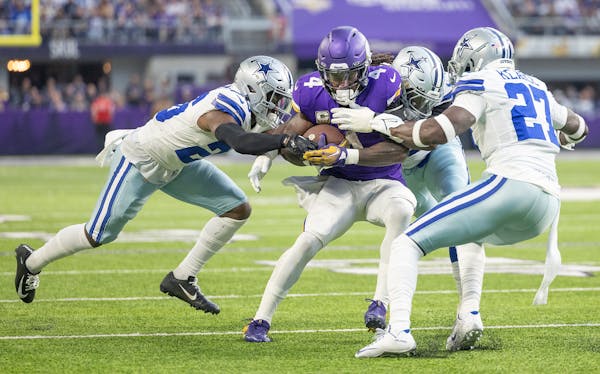Many times after close victories this season, Vikings players and coach Kevin O'Connell have talked about how the team, despite its gaudy record, has not played its best football yet.
The Vikings have also leaned on the hope of further progress after both of their losses this season: a 24-7 defeat at Philadelphia in Week 2 and a 40-3 loss to the Cowboys on Sunday that ranked as the second-largest home defeat in team history.
Their loss on Sunday put them in a strange position. According to ESPN Stats and Information, the Vikings are the first team in NFL history to be 8-2 or better with a negative point differential; they've been outscored by two points this season 231-229.
On Thursday night, the Vikings will face a Patriots team that has held its last two opponents to a field goal apiece, and ranks second in the league in points allowed (16.9). It seems like a natural time to ask the question: When will the Vikings' offense look like a finished product?
There are still several areas where they're likely not as sharp as they could be. They have struggled to finish drives in the red zone the past three weeks after a stretch where they were almost automatic near the goal line. The Vikings have run the ball only 10 times in goal-to-go situations this year, and still seem to be finding the right role for running back Dalvin Cook, who's carried only 42 times in the past three games.
Their offensive line still has players learning to work together, particularly on the right side, with rookie Ed Ingram at right guard.
Quarterback Kirk Cousins has been more aggressive in recent weeks, but he still seems to be finding a balance in an offense that's asked him to trust Justin Jefferson (and himself) more often with tight throws.
There are details with pass protection calls, offensive line technique, run game approach and the depth and timing of routes that the general public will never fully know.
And when Jefferson talked candidly on Monday about how the Vikings needed to change their game plan to deal with the Cowboys' pass rush sooner, he mentioned the learning curve the Vikings are still going through.
"Of course, I wish we adjusted faster throughout the game: getting the ball out quicker, not letting Micah Parsons and the rest of their D-line get back there to Kirk," he said. "It's just things that we need to learn from. This is a new team. This is a new coaching staff. We have new players on this team. We're all still learning each other. We're all still learning how to play with each other. It's just a lesson learned, just like Philly — it was a lesson learned that week.
"Throughout this season, we're learning things about each other, learning ways to win. It's all going to turn out better for us when we get to that stretch where we need to win, where we need to know what to do and how to change up the plan if things are not going well."
The Vikings rank 13th in the league in points and 18th in yards; they believe they have the talent and scheme to field one of the NFL's most productive offenses. Will that suddenly happen this week? Perhaps not, but they're banking on it happening before the playoffs in January. They still have a four-game lead in the NFC North, and could clinch the division by early December.
Their hope is, by the postseason, they'll have full cohesion between O'Connell's scheme, Cousins' leadership of the offense and the rest of the roster's execution during games.
And if that doesn't happen and this somewhat-unexpected run to the top of the NFC standings yields a quick playoff exit, the Vikings will have a year's worth of data to inform their offseason decisions about how the offense should look moving forward.
Do you have a big question about the Vikings? Email it to Ben Goessling, Andrew Krammer or Michael Rand, or tweet it to @AccessVikings and listen for answers on the Access Vikings podcast.


